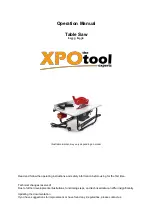
TRADUCTION OF THE ORIGINAL INSTRUCTIONS FOR USE
BS 300/60 AFI-E ED.2010 rev.00
14/61
5)NOT-FERROUS
ALUMINIUM
AL99.5 GalSi15Mg
--
300
50
2
Med/Lo
w
2%
BRONZE
CuSn6 CuSn6Zn
--
120
40
2 1
Med/Hig 2%
COPPER
G.Cu Ke.Cu
--
200
50
2
LOW
2%
3. INSTRUCTIONS FOR USE AND WARNINGS
This machine can make automatic work cycles, however at the end of each one the operator has to remove
the material that has been cut and possibly change the cutting conditions. Therefore the saw sometimes
must be manually adjusted and then it works in automatic cycle (so the operator is not indispensable).
The working cycle ends when the machine stops; in order to begin a new cycle, the starting procedure will
have to be repeated.
This machine is designed and manufactured so as to be safely used by the operator, provided that it is
properly operated . No protections will ever suffice if the operator does not work with due caution, does not
make sure that the machine is in top operating conditions and does not follow the instructions below.
You must remember that the machine is designed to CUT METALS with a sharp tool, and you are
responsible to see that it is operated in a SAFE and CORRECT manner.
1. make sure that the machine is properly installed and electrical installation is proper.
2. be sure you are familiar with all operating, safety, and applications information before running this saw.
3. see that all who operate this machine are properly trained and fully aware of all safety practices.
4. do not expose yourself or other people to any risk.
5. insist on proper personal protective equipment and practices.
6. maintain all factory-installed SAFETY DEVICES and make sure that these are never removed or altered or
restricted in any way.
7. the operator must have a safe and organized work area with suitable light and operating room.
8. the whole equipment has to be correctly and constantly maintained and inspected on a regular basis.
9. never use tools with different features from those for which the machine is designed for.
10.never use this machine to cut material bigger than the cutting capacity.
11. keep the cutting area clear of tools or other loose objects.
12. never operate the saw unless all protections are in place.
13. NEVER WEAR loose clothing, long sleeves, large gloves, jewelry, or any other items that may be trapped
into a part of the equipment. Confine long hair.
14. always disconnect the power at source when performing maintenance or making adjustments.
15. never insert hands or arms into or near the cutting area while machine is running.
16. properly clamp the material in the vice and never hold it with your hands.
17. support suitably the bar on both sides of the machine to prevent falling.
We recommend to connect an unloading table in case the cutting length of the material is longer than the
distance between the blade and the right edge of the saw.
18. when cutting very short pieces, make sure they do not jam into the blade.
19. if the blade becomes jammed, turn immediately off the emergency locking button, then move the cutting
unit to the CUTTING START position. If this is not possible, open the vice and move the piece, check that the
blade or teeth are not broken, if so replace it.
20. never change the working conditions when cutting, with exception of those specifically allowed (for
example, changing speed with the Inverter).
21. do not move the saw while cutting and avoid its instability.
22. wear personal safety equipment, if required for a safe operation.
ALWAYS OPERATE THE MACHINE SAFELY,
USING COMMON SENSE AND ALERTNESS
On some parts of the machine there are some stickers which warn about the safety measures that have to be
taken by the operator who runs it. Their meaning (easy to understand) is indicated in the following chart
Summary of Contents for BS300/60 AFI-E
Page 4: ...TRADUCTION OF THE ORIGINAL INSTRUCTIONS FOR USE BS 300 60 AFI E ED 2010 rev 00 3 61...
Page 16: ...TRADUCTION OF THE ORIGINAL INSTRUCTIONS FOR USE BS 300 60 AFI E ED 2010 rev 00 15 61...
Page 38: ...TRADUCTION OF THE ORIGINAL INSTRUCTIONS FOR USE BS 300 60 AFI E ED 2010 rev 00 37 61...
Page 39: ...TRADUCTION OF THE ORIGINAL INSTRUCTIONS FOR USE BS 300 60 AFI E ED 2010 rev 00 38 61...
Page 40: ...TRADUCTION OF THE ORIGINAL INSTRUCTIONS FOR USE BS 300 60 AFI E ED 2010 rev 00 39 61...
Page 41: ...TRADUCTION OF THE ORIGINAL INSTRUCTIONS FOR USE BS 300 60 AFI E ED 2010 rev 00 40 61...
Page 42: ...TRADUCTION OF THE ORIGINAL INSTRUCTIONS FOR USE BS 300 60 AFI E ED 2010 rev 00 41 61...
Page 43: ...TRADUCTION OF THE ORIGINAL INSTRUCTIONS FOR USE BS 300 60 AFI E ED 2010 rev 00 42 61...
Page 44: ...TRADUCTION OF THE ORIGINAL INSTRUCTIONS FOR USE BS 300 60 AFI E ED 2010 rev 00 43 61...
Page 45: ...TRADUCTION OF THE ORIGINAL INSTRUCTIONS FOR USE BS 300 60 AFI E ED 2010 rev 00 44 61...
Page 46: ...TRADUCTION OF THE ORIGINAL INSTRUCTIONS FOR USE BS 300 60 AFI E ED 2010 rev 00 45 61...
Page 47: ...TRADUCTION OF THE ORIGINAL INSTRUCTIONS FOR USE BS 300 60 AFI E ED 2010 rev 00 46 61...
Page 48: ...TRADUCTION OF THE ORIGINAL INSTRUCTIONS FOR USE BS 300 60 AFI E ED 2010 rev 00 1 61...
Page 49: ...TRADUCTION OF THE ORIGINAL INSTRUCTIONS FOR USE BS 300 60 AFI E ED 2010 rev 00 2 61...
Page 50: ...TRADUCTION OF THE ORIGINAL INSTRUCTIONS FOR USE BS 300 60 AFI E ED 2010 rev 00 3 61...
Page 51: ...TRADUCTION OF THE ORIGINAL INSTRUCTIONS FOR USE BS 300 60 AFI E ED 2010 rev 00 4 61...
















































